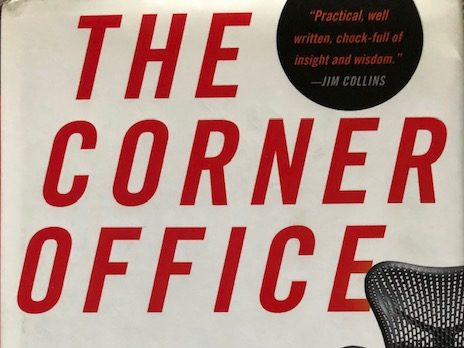CONVERSATIONS 9/18
From experience I know that sharp, exceptional leadership in retail is critical and a building block for a brand to succeed whether in stores, headquarters, distribution centers,or the marketplace.
For many years I had been a devoted reader of “Corner Office”in the Sunday New York Times business section. Pulitzer Prize−winning editor Adam Bryant conducted interviews with hundreds of CEOs from a broad range of organizations for the weekly column, as well as his book The Corner Office: Indispensable and Unexpected Lessons from CEOs on How to Lead and Succeed.Across ten to twelve probing questions,leaders shared incredible insights on a variety of leadership fronts⎯creativity, problem solving, people management, risk taking,and so much more.
Often upon completion of reading great nonfiction works (centered around business, health, leadership, etc.)I will record critical insights and takeaways that resonate with me that I wish to periodically review. Many insights shared in Bryant’s work are central to my approach to leadership. Below are some standout highlights from his book⎯enjoy.
KEY POINTS
•On CEOs:”They listen, learn, assess what’s working, what’s not and why, and then adjust. They are quick studies, and they also tend to be good teachers, because they understand the process of learning and can explain what they’ve learned to others.They seem eager to discuss their hard-earned insights rather than hold on to them as if they were proprietary software.. . . They put a premium on direct and frank communication and flattening the organization. They try to use questions more than statements, so their employees take ownership of their roles rather than simply take orders.”
•“. . . reward honesty and input, and show their interest in learning what others think, by holding town-hall meetings, seeking the advice of people at all levels of the company, and asking employees what they would do if they were in charge.”
•“. . . create a culture of learning in their organizations, so that, collectively, employees can adjust to the constant changes and challenges of business.”
•“There is no single way to lead or manage. We all have to figure out what makes sense on our own and develop our own story lines as leaders.”
•“If you give positive vibes, if you show interest, by and large a lot of people will react.”
•“It’s a positive attitude mixed with a sense of purpose and determination.”
•“[I]t’s about seeing the world on their terms and then dealing with them on their terms, not yours. . . .Part of team work is understanding the roles that different personalities play in a group. . . . People have to believe in you.”
•“Business is not always as complicated as it sometimes appears to be, nor should it be. . . . ‘Simplicity is the ultimate sophistication,’said Leonardo da Vinci.”
•“[T]hree things that matter. . . competence. . . confidence. . . caring.”
•“Go and find out who you are and what you can deal with and put yourself in some positions that will be distinctly uncomfortable. Forcing yourself out of your comfort zone is a great lesson in life.”
•“It’s important that you communicate clearly with people who are going to be reporting to you, that you be as open as possible about who you are, what they should know about you, what they should understand about you, and how you like to operate.”
•On smart interviewing:“I have to get a feeling that this person is going to be able to inspire people. . . can handle working without a clear roadmap.. . . [I]f someone is self-aware, then they can always continue to grow. If they’re not self-aware, I think it’s harder for them to evolve or adapt beyond who they already are.”
•“[E]xecutives have to make the time to get out and walk around, and they have to find other ways to learn what people are really thinking.”
•On visiting stores:“I always make it a good experience. . . seeing exactly what our customer is seeing. . . . I’m sort of out there in the white noise and messiness of it all.. . . Being on the floor signals I consider myself part of⎯not above⎯the team.”
•“Be a coach, not a critic. As a coach, a manager’s job is to elevate individual players, make the team better, and try to give guidance and input on the front end rather than just take potshots on the back end.”
•“Management is about results.. . . Leadership is an art.. . . People report to managers, but they follow leaders.”
•“[T]he job of leadership is developing people,and that involves not doing everything for them.”
•“Take ninety days. The relationships you build in that period will be critical to your success.”
•“People learn to lead through experience; there are really no short cuts.”

